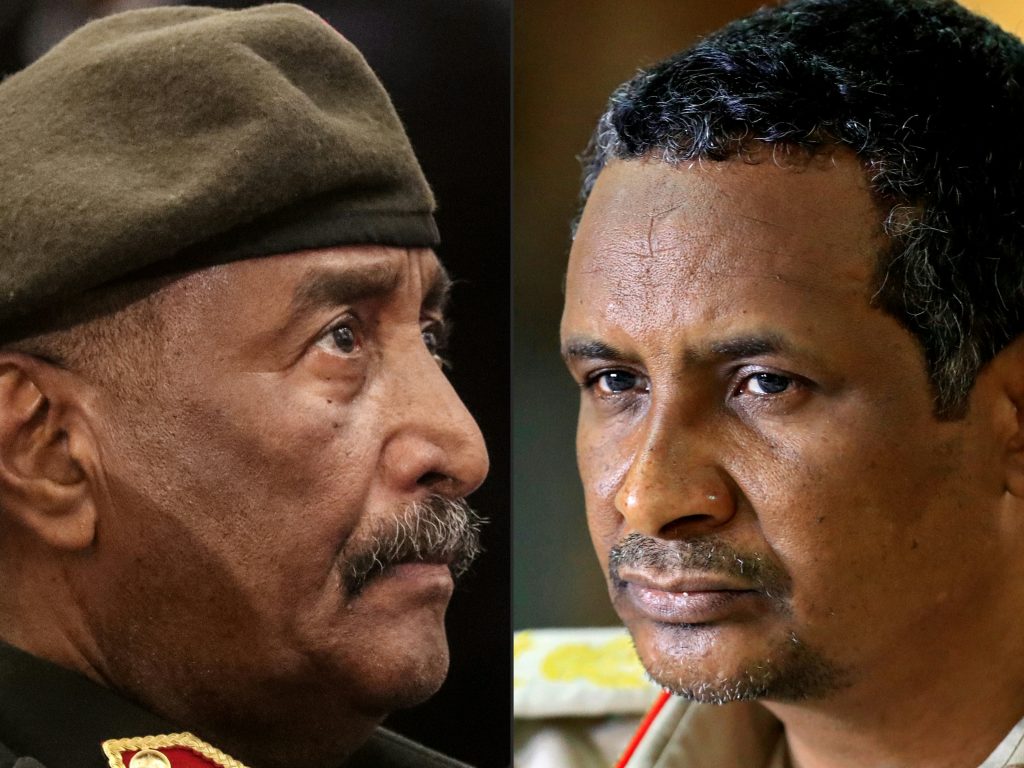
For the past week, forces loyal to Sudan’s army chief Abdel Fattah al-Burhan and rival fighters of Mohamed Hamdan Daglo’s paramilitary Rapid Support Forces (RSF) have been battling for control.
More than 400 people have been recorded as killed and thousands wounded, but the toll is expected to be far higher, with witnesses describing corpses lying on the streets as fighting rages.
AFP looks at the two main forces fighting in the worsening conflict.
– How big are the forces involved? –
The Military Balance+, compiled by International Institute for Strategic Studies (IISS), estimates that the army has 100,000 troops, compared with the RSF’s 40,000 fighters.
However, several experts have put forward the figure of 100,000 RSF troops, while giving numerical superiority to the army, or Sudanese Armed Forces (SAF).
But on the ground, neither side seems to have seized the advantage in nearly a week of bitter fighting.
Alex de Waal, academic with a longtime focus on Sudan, said the two forces have a “comparable size and combat capacity”.
There are no exact figures as to sizes of the two forces — since the conflict exploded precisely because of the dispute between the two generals on the methods of integrating the RSF into the regular army.
Burhan wanted to do this within two years, by imposing the army’s recruitment criteria on the paramilitaries.
Daglo, also known as Hemeti, wanted a 10-year window and also ranks equivalent to those awarded in 2013 to RSF fighters who led the war in Darfur for autocrat Omar al-Bashir, before his ouster in 2019.
– What are the military objectives? –
“Neither SAF nor the RSF has much incentive to back down,” said Aly Verjee of the Rift Valley Institute.
The two forces normally fight together against rebel groups in far-flung provinces, but this time they are in a race against time as they fight each other on unfamiliar terrain: Khartoum.
The RSF wants to prolong the conflict, while the army was aiming to use its warplanes to weaken the paramilitary force as quickly as possible, said Verjee.
“Hemeti… has an interest in stretching out the conflict” since the main difference “in capacity between the SAF and the RSF is air power”, said Verjee.
– What political goals do they have? –
For Jehanne Henry, a US human rights lawyer who has monitored Sudan for years, “doomsday scenarios run the gamut”.
If the army wins, “Burhan and his colleagues will re-install old regime Islamists” and ignore international pressure, as they did during decades of international embargo under Bashir’s rule.
“At best, they could make a flimsy pretence of appointing some allied civilians,” Henry said.
The other possibility was that the RSF win, but that scenario was seen as less likely, she added.
In such a case, “they won’t go down easily, and could draw out the conflict, allying with other armed groups in peripheral areas”.
– What are their international allegiances? –
In the north, “Egypt, seen as a would-be coloniser, supports the SAF and has an interest in Sudan’s Nile water and agricultural land”, said Henry.
To the south, Ethiopia “has its own interests, including to counter Egypt”, she said.
In the east, “the United Arab Emirates, which supported Hemeti, has benefited from the RSF’s participation in the Saudi coalition in Yemen, and may have sold weapons to the RSF”, she added.
As for Chad and Libya, which border Daglo’s stronghold in Darfur, these desert countries are possible channels for ammunition and reinforcements.
For its part, the International Crisis Group think tank warned the “risk of spillover” could grow as the conflict “might directly involve ethnic groups whose homelands straddle their borders with Sudan”.
bur/pjm/dv/srm
© Agence France-Presse